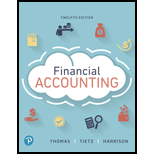
Financial Accounting (12th Edition) (What's New in Accounting)
12th Edition
ISBN: 9780134725987
Author: C. William Thomas, Wendy M. Tietz, Walter T. Harrison Jr.
Publisher: PEARSON
expand_more
expand_more
format_list_bulleted
Question
Chapter 9, Problem 9QC
To determine
To Identify: The amount of interest expense if the bonds are issued at discount and if effective- interest method is used.
Expert Solution & Answer
Want to see the full answer?
Check out a sample textbook solution
Students have asked these similar questions
Increase it's fixed assets? Find correct option
Hello tutor please help me this question general accounting
Hy expert give me solution
Chapter 9 Solutions
Financial Accounting (12th Edition) (What's New in Accounting)
Ch. 9 - Brownlee Company issued 525,000, 8%, six-year...Ch. 9 - A bond with a face value of 250,000 and a quoted...Ch. 9 - Mission Furniture issued 500,000 in bonds payable...Ch. 9 - Bonds with an 8% stated interest rate were issued...Ch. 9 - Brimfest Corporation issued 2,400,000, 10-year, 6%...Ch. 9 - The Discount on Bonds Payable account a.is an...Ch. 9 - The discount on a bond payable becomes...Ch. 9 - The carrying value of Bonds Payable equals a.Bonds...Ch. 9 - Prob. 9QCCh. 9 - Prob. 10QC
Ch. 9 - Prob. 11QCCh. 9 - When a company retires bonds early, the gain or...Ch. 9 - Which type of lease will not increase a companys...Ch. 9 - Prob. 14QCCh. 9 - The debt ratio is calculated by dividing: a. total...Ch. 9 - Prob. 16QCCh. 9 - Prob. 17QCCh. 9 - Prob. 9.1ECCh. 9 - Prob. 9.1SCh. 9 - (Learning Objective 1: Determine bond prices at...Ch. 9 - (Learning Objective 1: Journalize basic bond...Ch. 9 - Prob. 9.4SCh. 9 - Prob. 9.5SCh. 9 - Prob. 9.6SCh. 9 - Prob. 9.7SCh. 9 - Prob. 9.8SCh. 9 - (Learning Objective 2: Account for bonds payable...Ch. 9 - Prob. 9.10SCh. 9 - LO 4,5 (Learning Objectives 4, 5: Deferred income...Ch. 9 - LO 5 (Learning Objective 5: Compute and evaluate...Ch. 9 - LO 5 (Learning Objective 5: Calculate the leverage...Ch. 9 - LO 6 (Learning Objective 6: Report liabilities)...Ch. 9 - (Learning Objective 1: Issue bonds payable...Ch. 9 - Prob. 9.16AECh. 9 - Prob. 9.17AECh. 9 - LO 2 (Learning Objective 2: Issue bonds payable...Ch. 9 - Prob. 9.19AECh. 9 - LO 4 (Learning Objective 4: Account for deferred...Ch. 9 - (Learning Objective 5: Evaluate debt-paying...Ch. 9 - LO 4, 5 (Learning Objectives 4, 5: Analyze current...Ch. 9 - Prob. 9.23AECh. 9 - (Learning Objective 1: Issue bonds payable...Ch. 9 - Prob. 9.25BECh. 9 - Prob. 9.26BECh. 9 - Prob. 9.27BECh. 9 - Prob. 9.28BECh. 9 - LO 4 (Learning Objective 4: Account for deferred...Ch. 9 - Prob. 9.30BECh. 9 - Prob. 9.31BECh. 9 - Prob. 9.32BECh. 9 - A bond with a face amount of 12,000 has a current...Ch. 9 - The carrying value on bonds equals Bends Payable...Ch. 9 - Prob. 9.35QCh. 9 - Prob. 9.36QCh. 9 - Prob. 9.37QCh. 9 - Prob. 9.38QCh. 9 - Prob. 9.39QCh. 9 - Prob. 9.40QCh. 9 - Prob. 9.41QCh. 9 - Prob. 9.42QCh. 9 - Prob. 9.43QCh. 9 - Prob. 9.44QCh. 9 - Prob. 9.45QCh. 9 - Prob. 9.46QCh. 9 - Prob. 9.47QCh. 9 - Prob. 9.48QCh. 9 - Prob. 9.49QCh. 9 - Prob. 9.50APCh. 9 - (Learning Objectives 1, 6: Issue bonds at a...Ch. 9 - Prob. 9.52APCh. 9 - Prob. 9.53APCh. 9 - (Learning Objectives 2, 3, 6: Issue convertible...Ch. 9 - Prob. 9.55APCh. 9 - Prob. 9.56BPCh. 9 - Prob. 9.57BPCh. 9 - Prob. 9.58BPCh. 9 - Prob. 9.59BPCh. 9 - (Learning Objectives 2, 3, 6: Issue convertible...Ch. 9 - (Learning Objectives 4, 5, 6: Report liabilities...Ch. 9 - Prob. 9.62CEPCh. 9 - Prob. 9.63CEPCh. 9 - Prob. 9.64SCCh. 9 - (Learning Objective 5: Explore an actual...Ch. 9 - Prob. 1FF
Knowledge Booster
Similar questions
arrow_back_ios
SEE MORE QUESTIONS
arrow_forward_ios
Recommended textbooks for you
- Principles of Accounting Volume 1AccountingISBN:9781947172685Author:OpenStaxPublisher:OpenStax College
 Cornerstones of Financial AccountingAccountingISBN:9781337690881Author:Jay Rich, Jeff JonesPublisher:Cengage Learning
Cornerstones of Financial AccountingAccountingISBN:9781337690881Author:Jay Rich, Jeff JonesPublisher:Cengage Learning

Principles of Accounting Volume 1
Accounting
ISBN:9781947172685
Author:OpenStax
Publisher:OpenStax College


Cornerstones of Financial Accounting
Accounting
ISBN:9781337690881
Author:Jay Rich, Jeff Jones
Publisher:Cengage Learning